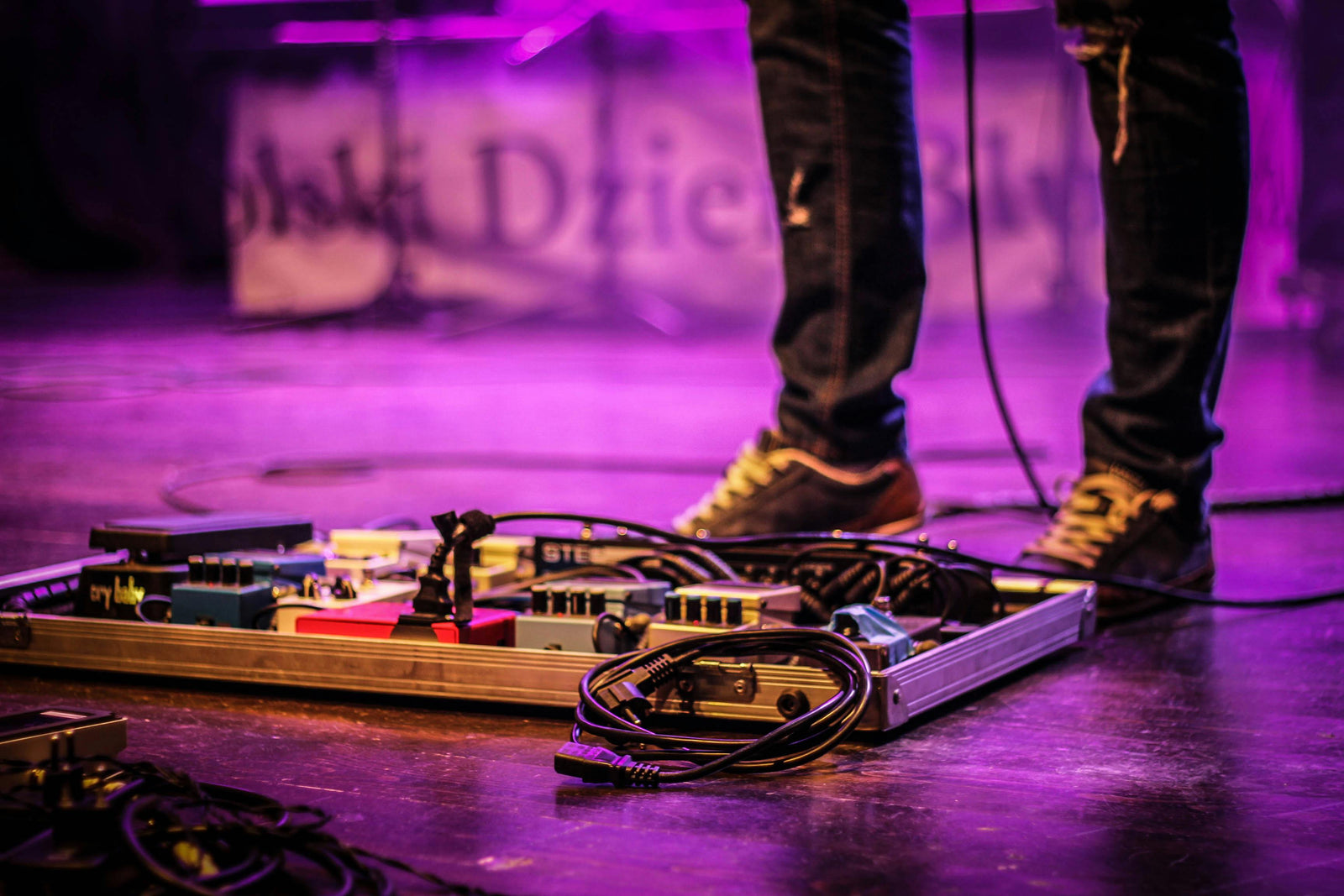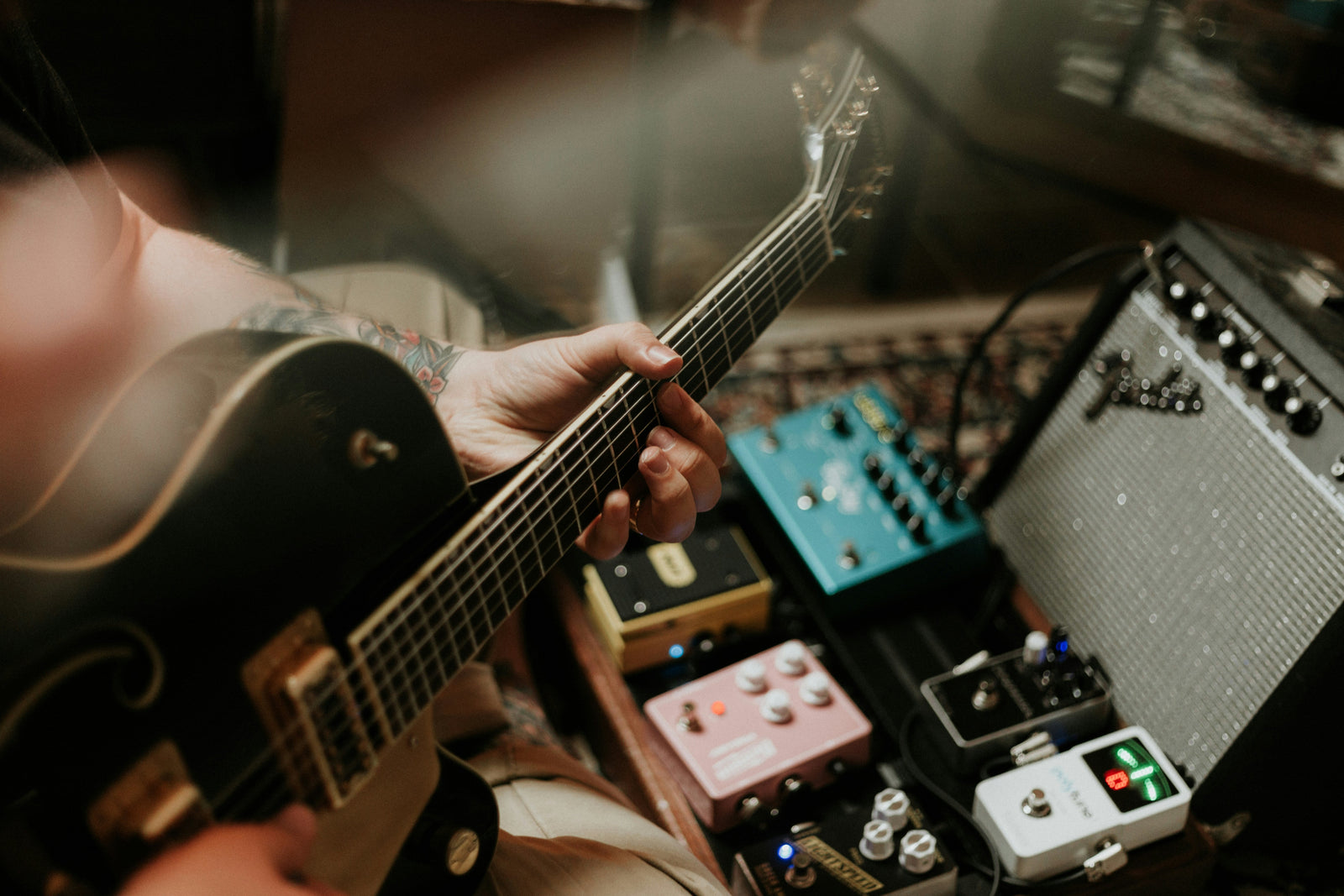BOSS Guitar Pedals: Booster/Preamp
Boost and preamp pedals are essential for guitarists looking to elevate their sound. They serve not only to increase the signal level but also to sculpt your tone in nuanced ways.
Understanding the difference between these pedals is key to maximizing their potential. Boost pedals amplify your signal without changing its character.
In contrast, preamp pedals shape your tone. Adding a preamp pedal to your setup offers refined sound control. This is especially useful for clean tones or mimicking tube amplifier warmth. Preamps work with power amps, enhancing the sound quality and providing versatility.
They offer a wide range of tones, from crystal-clear to overdriven. This makes them invaluable for both live performances and studio recordings.
Exploring guitar preamps offers new tone-shaping options. Understanding these pedals enhances musical expression for all skill levels.
What Are BOSS Guitar Pedals Preamps?
Modern guitarists have access to plenty of high-quality gear. This access simplifies the process of crafting favorite tones. The popularity of digital modeling amps and pedals is growing. Many now prefer these over traditional valve amplifiers. These alternatives stand out for their versatility, reliability, and portability.
Preamp pedals play a key role in this trend. They deliver the sounds of large amps in small, affordable packages. Viewers consider these pedals practical alternatives to conventional amps.
A preamp pedal lets you plug into a mixer or PA, simulating amplifier sounds. You can connect it to an amplifier's power section for extra tone shaping. This versatility makes preamp pedals a favorite among guitarists. They allow for direct performance and recording setups without losing tonal quality.
Preamp pedals bring the essence of large amps to smaller, manageable formats. Their ability to mimic amplifier characteristics makes them invaluable. Whether for live gigs or studio sessions, preamp pedals provide a reliable solution. They ensure guitarists can achieve their desired sound anywhere.
The evolution towards more practical gear like preamp pedals reflects modern musicians' needs. These pedals support a wide range of genres and playing styles. Understanding preamp pedals opens up new possibilities for guitarists. They are a testament to how far music technology has come.
For guitarists looking to streamline their setup, preamp pedals are a game-changer.
How Do Preamps Guitar Pedals Work?
A preamp pedal emulates a guitar amplifier's preamp section. Most use solid-state circuitry for enhanced reliability and longevity. This design choice avoids the fragility and end issues of tubes. Despite lacking valves, these pedals still deliver convincing sounds. They come equipped with EQ controls for sound shaping, like real amps. Gain circuits in preamp pedals to enable overdriven tones. The preamp pedal market offers diverse options for all budgets. Advanced models feature many channels for sound switching. Some also include comprehensive controls for fine-tuning tones.
Guitar preamp pedals are the first amplification stage in your signal chain. They shape and boost the signal before it reaches the power amp. Preamps, once integral to amplifiers, are now available as separate units. Incorporating a preamp pedal offers versatility and precise tone control. You can adjust gain, and EQ, and mimic different amp models with them. This control tailors your sound for various styles and genres.
Introducing a preamp pedal can address common tone issues, like tinny sounds. It adds warmth and body, balancing your tone. Preamp pedals also help pristine clean tones. Driving the preamp allows for rich cleans at low volumes. This is ideal for recording and performing with clear, low-volume tones.
What Are BOSS Guitar Pedals Booster?
Boost pedals amplify your signal. They're used to increase amplifier volume or stress song sections. This helps certain parts stand out in the mix. A variety of boost pedals are available from many brands. Options range from clean boosts to those that add volume and enhance tone.
Boost pedals offer versatility beyond simple amplification. They can elevate the entire pedalboard. Also, boost a particular effect, or push your amp into overdrive. Having many boost units on a board is often beneficial. The market offers an array of boost pedals, from simple to feature-rich models. These units can refine your tone.
Essential for both live and studio settings, a boost pedal is a crucial tool. It's about more than volume; it's about enhancing tonal quality. Delving into the boost pedal selection can help find the right match for your needs. With a boost pedal, fine-tuning your sound becomes straightforward. They provide an easy way to adjust your instrument's output.
How Do Booster Guitar Pedals Work?
Musicians often use boost pedals to enhance specific parts of a song. They help solos stand out in a mix, especially against other instruments. Boost pedals aren't limited to volume increases; they stress overdrive too. Placing a boost before an overdrive pedal can produce a unique drive texture. This technique creates a thicker drive tone, like high-output pickups. Boost pedals can also generate more amplifier gain at lower volumes. They raise amp gain, not volume, as an overdrive alternative for classic rock. Boost pedals can also refine and increase an amplifier's output.
Boost pedals provide versatility; you can place them before the amp or in its effects loop. When before the amp, they enhance its character, especially alongside distortion or overdrive. This setup enriches harmonics and extends note sustain. Using a boost before distortion adds color and saturation without increasing loudness. Interaction varies, but boost pedals generally enrich the sound.
Different Types of Booster Pedals
Booster pedals come in two types: clean boost and treble boost. Clean boost pedals aim to increase volume without altering tone. They don't affect the amp's gain stage. Treble boosters, so, enhance more than high frequencies. They also amplify mids and upper mids, adding color to your sound. Think of treble boosters as combining an EQ pedal with a boost. These pedals are versatile, serving roles as overdrives, preamps, and alternative drive voicings.
Clean boosts are ideal for pure volume increase, maintaining your guitar's natural sound. Treble boosts, yet, are perfect for cutting through a mix with enhanced clarity. Each type suits different musical needs and preferences. Clean boosts work well in any setup, providing a straightforward signal boost. Treble boosts are valuable for specific tonal adjustments, enriching the guitar's voice. For volume or tone enhancement, there's a suitable booster pedal.
Understanding these differences helps tailor your rig for the perfect sound. Booster pedals thus offer significant flexibility in shaping guitar tones.
BOSS Guitar Pedals Booster Controls
Boost pedal controls differ across models, with many featuring a simple level control. This applies to both clean and treble boosts, where EQ often remains fixed. In pedals like the BOSS BP-1W, the level knob increases decibel output. The gain control adds grit and analog drive to your tone. The BP-1W's level and gain controls interact with an amplifier's. Adjusting the level and gain can emphasize one over the other. Some boost pedals also function as preamps and include an EQ section.
The BOSS FA-1 FET, for instance, offered bass and treble controls for tone shaping. Others, like the BP-1W, feature a switch for global EQ settings. This switch selects flat, RE series Space Echo, or CE-1 preamp tones. These features offer versatility in tone shaping and sound customization. The interaction between controls allows for nuanced sound adjustments.
BOSS Guitar Pedals Booster/Preamp: Differences
Exploring BOSS guitar pedals can be like navigating a maze. Boost and preamp pedals shine for their distinct roles. Understanding their differences can elevate your sound. Boost pedals amplify your guitar's signal, adding volume. This is great for solos or standout sections.
Preamp pedals shape your sound more. They adjust EQ, adding warmth or brightness. Preamp pedals can connect to speakers, eliminating the need for an amp. Boost pedals enhance your guitar's natural tone. They increase volume without altering the sound's essence.
Both types are valuable to musicians. Bass players use them to mimic an amplifier stack's voicing. Preamp pedals provide depth and clarity to flat EQ amplifiers. Your choice between boost and preamp depends on your needs. A boost pedal is best for volume without tone change.
A preamp pedal offers tonal versatility and PA connectivity. The decision hinges on your sound and setup needs. By grasping their differences, you can make a choice that improves your music.
Booster and Preamp In Signal Chain
Boost and preamp pedals are key for tonal exploration. They offer more than a volume increase. These pedals can revoice your amp, bringing new life to your sound. They also tweak overdrive tones, adding unique characters.
Both types are essential for guitarists seeking sound diversity. Boost pedals shine in solo parts, making them stand out. Preamp pedals, so, shape the overall tone. They can be the cornerstone of your effects chain.
Combined, they offer a diverse array of tonal options. Their versatility makes them indispensable on any pedalboard. Experimenting with their placement can unlock new sounds.
1. Boost Guitar Pedals
A boost pedal can transform your sound when placed in the signal chain. It's usually positioned before the amplifier. With a tube amp, a boost increases both gain and volume. This boost adds more than volume; it enriches your tone with added characteristics.
Its placement on the pedalboard influences the outcome. At the chain's end, it offers a clear, clean boost. This is ideal for a pure signal lift without altering the tone. Placed before overdrives, it changes the drive tone, creating a richer saturation.
Positioning it at the start affects every pedal that follows. Here, it can shape the sound by adjusting EQ and gain. This placement is strategic for influencing your guitar's entire tonal landscape.
Boost pedals offer versatility in how your guitar interacts with other effects. At the chain's end, they maintain the signal's integrity. Before overdrives, they add depth to your drive tone.
2. Preamp Guitar Pedals
Placing a preamp pedal at the start of your effects chain shapes your sound foundation. It acts like an active guitar's EQ, adjusting the tone right from the start. This setting influences how other pedals process the signal.
Think of it as setting the stage for your guitar's voice. The preamp's EQ and gain settings pre-condition your sound. These initial adjustments color every effect that follows.
Moving a preamp pedal to the end of the chain changes its role. Here, it mimics your amplifier's preamp. This position refines your effects' tone before reaching the amp.
It's akin to having a final say in your sound's character. This placement ensures a cohesive tone, blending all effects. The preamp pedal becomes a master sculptor of your sound.
Whether at the start or end, a preamp pedal offers strategic tonal control. Its position can alter your guitar's output. Experimenting with its placement can unlock new sonic textures.
BOSS Guitar Pedals: Booster/Preamp
- IR-2 Amp & Cabinet
- BP-1W Booster/Preamp
- GE-7 Graphic Equalizer
- GEB-7 Bass Equalizer
- EQ-200 Graphic Equalizer
- IR-200 Amp & IR Cabinet
Top BOSS Guitar Pedals Booster/Preamp: GEB-7 Bass Equalizer
The BOSS GEB-7 Bass Equalizer is a key tool for bassists. It offers a seven-band equalizer, tailored for the bass frequency range. This pedal is perfect for both electric bass and upright bass with pickups. It extends from 50Hz to 10kHz, ensuring full sound shaping. The GEB-7 can boost or cut tones, ideal for live and studio use. It supports both electric-acoustic bass applications. It also operates with an AC adapter or a 9V battery.
Key features include:
- A 50Hz to 10kHz range, designed for bass.
- Functions as a "boost" or "cut" pedal.
- Works with AC adapter or 9V battery.
Its durable design is typical of BOSS guitar pedals. The metal housing and rubber base ensure longevity. The GEB-7 also has an easy-access battery compartment. This pedal is versatile and perfect for adjusting bass tones in any setting. It provides a wide range of sound adjustments. From boosting high mids for slapping to smoothing out highs for a thicker tone, invaluable. The level control allows for precise volume adjustments.
In short, the GEB-7 is a must-have for serious bassists. It enhances performance with its detailed equalization and robust build. This makes it a staple in any setup.
BOSS Guitar Pedals Booster/Preamp: Frequently Asked Question
Does a Preamp Pedal Improve Sound?
A preamp pedal can enhance your sound. It provides tone shaping beyond your amp's capabilities. Including one in your effects chain broadens your sonic options. This pedal allows for more nuanced sound adjustments.
It offers alternative tones, enriching your musical expression. With a preamp pedal, your tonal palette expands, inviting creativity.
How do I know if I need a preamp?
Determining the need for a preamp can be straightforward. Try connecting your turntable to a computer or recording device. Record your vinyl records to test the sound level. If the recording level is satisfactory, a preamp isn't necessary.
However, a low recorded level indicates the need for a preamp. A preamp will boost your signal to an optimal level.
Is the boost guitar pedal the same as overdrive?
While similar, boost and overdrive pedals have distinct purposes. A boost pedal increases volume and signal strength, enhancing your tone. Conversely, an overdrive pedal introduces more gain, saturating your tone further. When used with a clean, low-wattage valve amp, overdrive pedals push the amp to break up even more. This results in a rich, saturated tone with increased gain.
Musicians use overdrive pedals to achieve a driven, distorted sound. Understanding these differences helps you choose the right pedal for your needs. Whether boosting volume or adding gain, both pedals have their place.
BOSS Guitar Pedals Booster/Preamp: Conclusion
BOSS guitar pedals, both booster and preamp, stand out in the music gear landscape. These pedals are pivotal for players aiming to refine their sound. A booster pedal from BOSS can elevate your solos to new heights. Meanwhile, their preamp pedals shape your tone with precision.
Both types offer unmatched versatility and quality. They are tools for creativity, allowing musicians to sculpt their signature sounds. BOSS's reputation for durability means these pedals are gig-ready.
Whether boosting volume or adjusting tone, BOSS has you covered. These pedals complement each other, enhancing any pedalboard. Incorporating them into your setup invites tonal exploration. In conclusion, BOSS guitar pedals booster and preamp are essential for serious guitarists. Their impact on sound and performance is profound.





